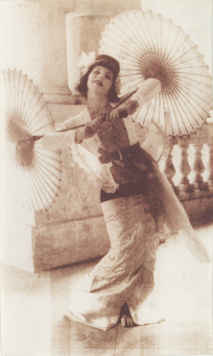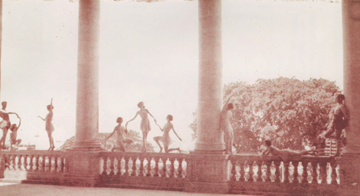Dance: Singapore Through Old Eyes vs. New (Memoir)
By Jane Sherman
ART TIMES March 2001
 A Burmese Yein Pwe, 1926 Jane Sherman in costume and pose for the finale, photographed on the balcony of Victoria Theatre, Singapore |
SITTING AT MY desk in the Actors' Fund-Assisted Living Residence in Englewood, New Jersey on one of the coldest, snowiest days of the winter, it is difficult to believe the daily 100˚ heat—100% humidity of a Singapore that I endured almost three-quarters of a century ago. Then, as a 17-18 year old, I was the youngest member of the Ruth St. Denis-Ted Shawn Denishawn Dancers on their fifteen-month tour of the major countries of the Far East, during which the crossroads of Singapore became a frequent and most romantic stop, where we performed, rehearsed, went sight-seeing, shopped for costumes and souvenirs, attended special demonstrations of various dance cultures, spent tropical nights learning new jazz steps with new love-lorn swains, and recuperated from weird tropical afflictions — all in the unending and non-air-conditioned sauna of the Malay Straits.
Cornelia Seckel's reports in ART TIMES [November, December 2000 Issues] of her recent impressions of Singapore electrified my memories to the point of shock — of course I had seen and read of the desirable as well as the undesirable globalization changes that had inevitably taken place there. Yet perhaps because Cornelia's modern experiences were involved with the arts — as were my much earlier ones — her vivid descriptions turned shock into reality. Here, for instance, is how she first saw the city in the year 2000:
After arriving at Changi Airport (traditional and contemporary art was hung along the long corridors as I made my way to immigration and my baggage)…The moment I stepped out of the air-conditioned airport (practically all buildings are air-conditioned) my hair began to curl—humidity is between 70—90% and…the temperature averages 95˚
From my hotel room I could see the Singapore River with old abandoned warehouses and…60-story contemporary-styled offices and hotels, some completed, some still under construction.
From my 1976 book, Soaring: The Diary and Letters of a Denishawn Dancer in the Far East (1925-1926, (Wesleyan University Press):
Here I am in one of the most beautiful spots in the world! Let me tell you about it:
It is low, no hills until further inland, and everywhere are palms and rich green that rests your eyes to look at. The harbor is not quite as picturesque as Hong Kong. The houses are all cream and white stucco, built low, with many porches and surrounded by cool shrubbery. Along the waterfront is another "Riverside Drive," with a war monument and a park. A few rather tall (no more than ten stories) office buildings. A lovely old grey cathedral in the center of a huge greensward sheltered by gnarled trees and soft vines. Its dignified spire is the first thing one sees when coming into the harbor and its quarter-hourly chimes can be heard throughout the city…
 Anne Douglas, Doris Humphrey and Ernestine Day demonstrating a pose from “Choer Dansé” on the veranda of the Victoria Theatre, Singapore, July 1926 Anne Douglas, Doris Humphrey and Ernestine Day demonstrating a pose from “Choer Dansé” on the veranda of the Victoria Theatre, Singapore, July 1926(L to R): G. Steares, M. Howry, Geordie Graham, Anne Douglas, Doris Humphrey, Ernestine Day, Jane Sherman, Pauline Lawrence, Charles Weidman |
This idyllic re-creation of a bit of England was right across the street from the hotel where the company stayed — a two-story, marble-floored structure where each front room had a modern bath, and a large private verandah facing the church.
It is so queer and wonderful to see white oxen with large horns, pulling a wooden cart along a paved road. These oxen are all over the city; they have tiny silvery bells jingling around their necks. They are sad-eyed creatures, mild and hard-worked. These carts and rickshaws and bicycles and buses and some private cars make up the busy traffic…
But what fills me with the most excitement are the people, a mixture of Chinese, Malays, and Hindus. This is my first sight of the people whose country we are soon going to visit (India). The men — Singhalese or Indian, I don't know which — have long black hair and wear bright batiks around their waists like skirts. Silver anklets and earrings are common. Their bodies are a deep brown and very smooth, like polished ivory or ebony. And oh! Their eyes! All the wisdom of the world seems to be sunk in those dark, mournful pools of liquid fire. They seem sad even when laughter makes their teeth glow white in their dark faces. The women wear saris and some have a huge gold thing like an earring just over each nostril. The babies don't wear much but a bright rag and anklets and bracelets of silver. They are darling, sad-eyed kiddies.
The homes for foreigners here are beautiful and there are exquisite golf links and bathing beaches safely enclosed from sharks…
Today's "busy traffic" has dramatically changed and increased, I know, but at least one landmark remains intact across the years: the Victoria Theatre. As Cornelia notes, it was built in 1862 to be Singapore's Town Hall, and became an "elegant old Concert Hall" that is now the home of the world-renowned Singapore Symphony Orchestra of 90 musicians, which programs 100 performances a year there.
 Denishawn Dancers in Nautch Costumes made for them in Bombay for their East Indian Ballet “In a Bunnia Bazaar” choreographed by Ruth St. Denis. A Rehearsal in Singapore for 1926-1927 US Tour. (L to R) Pauline Lawrence, Anne Douglas, Edith James, Jane Sherman, Geordie Graham and Ernestine Day. |
These are incredible statistics for the colonial hick town I remember, where the most exciting annual cultural event might be a revival of "Pinafore" as performed by the local Gilbert and Sullivan Society for a "whites only" audience. All else was polo and rugby, bridge and teas, parties and gossip, in a wasteland of snobbery and racism. Or so I observed.
The then largely un-booked Victoria Theatre became the Denishawners second home. We danced there every time our tour took us through the city to or from Hong Kong, Manila, and Java. We became blasé with baskets of orchids handed to us over the footlights — with handsome young men in white evening dress awaiting us at the stage door — with enthusiastic audiences filling the house time and again to see our four different programs. (I was not so blasé one night near my 18th birthday when I was called for by a uniformed syce (chauffeur) driving a cream-colored Rolls Royce convertible in which to take me to an after-theatre supper.)
In contrast, during a month-long lay-off in July, conditions were far from glamorous. We rehearsed in the enormous outdoor second-story verandah whose columns can be seen in Cornelia's photograph, where palm trees have grown 70-years taller above anything glimpsed in my snapshots. Several of us, including Ruth St. Denis and Ted Shawn themselves, worked even while suffering from dengue fever. Everyone was far too exhausted for any form of social life.
When our performances began again, we all felt better and our romantic routine resumed. One unusual break in the routine was a luxurious drive across the causeway to Johore in the Independent Malay States.
As Cornelia writes of a similar adventure on her last day in Singapore:
I decided to go to Santosa Island, the 'fun island' with many resorts and theme park attractions…[after] a little exploring of the World Trade Center — a complex that houses offices, exhibition halls, and shops as well as being Singapore's cruise center. I took the cable car over to the Island and that gave me a wonderful view of the Port area, the ships, and thousands of containers waiting to go to their next destination…I took the monorail for an overview and then an open trolley from one end to the other…
Cable car? Monorail? Trolleycar? Theme park attractions??? In 1926, a swain sent a new Buick-with-driver for our pleasure. Three of us decided we would like to see Johore:
It was a beautiful 27-mile drive, not hot or sunny or rainy, just cool. We drove through miles of rubber plantations and palms. At Johore we saw the Mosque and the gardens. Orchids sell here for 10¢ apiece! The brilliant reds. Yellows, purples, and pinks against the green remind me of Gauguin.
We took a different route home, through an honest-to-goodness jungle. All undergrowth, dense, trees growing so close you couldn't see far into it, and glorious flowering vines. Three large wild monkeys ran across the road in front of us, up a palm, then jumped from tree to tree into the jungle's darkness…
We also passed large pineapple fields because here, you know, we are within 60 miles of the Equator…
And this is my diary entry for December 18, 1925, referring to the Changi I knew, in contrast to Cornelia's airport of today:
I've never seen such a lovely spot as this family weekend place (where a Singapore admirer had arranged an after-theatre party for several of our chaperoned dancers to meet his family and friends),
The house is cream stucco and set among palms. A huge bush of purple flowers stood beside the porte cochère and yellow, orange, red, and lavender shrubs were everywhere. A terraced lawn led down to the sandy beach…The swimming area there is enclosed by a "peggar" — a wooden crib sunk into the water to keep out sharks. It has swings and a slide and a roof to keep off the scorching sun.
We swam for an hour — it felt good to be cool because the night was stifling — and then we all got dressed and sat down to a lovely supper at two in the morning!
The house is furnished barely, for coolth. High ceilings and wicker furniture. A Victrola, a piano, and a long dining room table. The verandah is a masterpiece, with a wonderful dance floor. There are four bedrooms and four baths with marble floors. There is a huge garage for their cars — the Bentley racer, the Lancastershire, the Morse, and a Baby Standard. Being only a weekend cottage, it isn’t furnished sumptuously but in excellent taste. It is placed high on the ground and has a wonderful view…
And as Cornelia enjoys her farewell airplane view up and over one of the busiest harbors in the world, she leaves me far below and far behind in my world where, from the same Changi:
…we then got into an electric canoe and went for a long ride across Singapore Bay and back into the sunset…
(Jane Sherman was a dancer, author, and former dance correspondent for ART TIMES died at the age of 101 in March, 2010. At the age of 17 she joined the Denishawn Dancers and toured Asia 1925-26).
